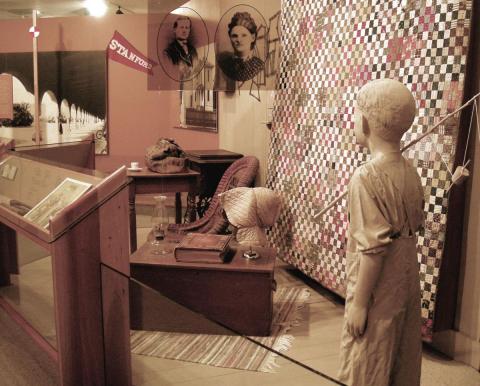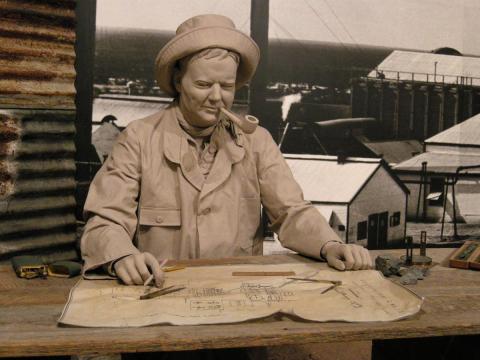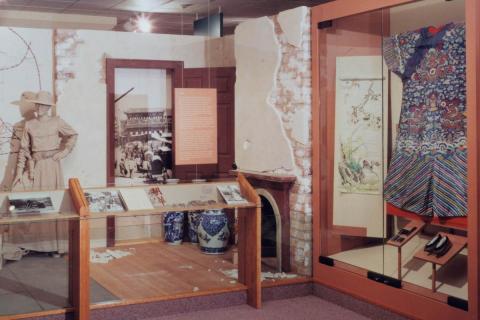On This Page
- Rendering Links ...
Years of Adventure 1874-1914
West Branch, Iowa

Herbert Clark Hoover was born on August 10, 1874, in the town of West Branch, Iowa. His Quaker father, Jessie Clark Hoover, a blacksmith and farm equipment salesman, died of a heart attack when Herbert was six years old. Three years later, Herbert's mother, Hulda Minthorn Hoover died from pneumonia. Herbert, his older brother Theodore, and younger sister Mary were orphaned. Herbert left Iowa at age 11 in November 1885, bound for Oregon and the home of his maternal uncle, Henry Minthorn, who was a doctor and school superintendent, and later, a real estate broker.
Oregon and Stanford
Herbert lived with the Minthorns for six years; at 14, he left school to work as a clerk in his uncle's real estate business. Three years later, having decided to pursue a career as a mining engineer, Hoover sought to resume his studies and applied to a new school, Leland Stanford Junior University, set to open in 1891.
It was at Stanford that he made lifelong friends, found a mentor in Professor John Caspar Branner, and met his future wife, Lou Henry. He was active in extracurricular activities, serving as student body treasurer and as manager of both the baseball and football teams. To help with college expenses he started a laundry service, did typing chores for his professor, and worked summers making geological maps.
Mining Career

After graduating from Stanford University in 1895 with a degree in geology, Hoover was unable to find work as a mining engineer so he took a job as a clerk in the San Francisco consulting firm of Louis Janin. Hoover so impressed Janin that when the British mining firm Bewick, Moering & Co. asked Janin to suggest an engineer to work for them in Australia, he recommended Hoover.
Hoover arrived in Western Australia in May 1897. The goldfields were located in the middle of the Great Victoria Desert, which Hoover described as a land of “black flies, red dust, and white heat.” Hoover spent the next eighteen months developing mines, installing equipment, and examining new prospects. As a result of his hard work in Australia, Bewick, Moering & Co. offered Hoover a position as a consulting engineer to the Chinese government, to assist with developing mines in China.
Marriage

While working in Australia, Hoover kept in touch with his friends and family in California. He provided financial support for his brother, sister and a cousin living in the Bay area, and began anonymously funding scholarships for students at Stanford University. He also kept in touch with his former classmate, Lou Henry. They had much in common: their Iowa roots, a love of the outdoors, and geology degrees from Stanford. After receiving his promotion from Bewick, Moreing and Co., Hoover sent Lou a brief telegram, “Going to China via San Francisco. Will you go with me?” She sent back one word: “yes!”
They were married in the living room of the Henry home in Monterey, California on February 10, 1899 by Father Ramon Mestres, a Catholic priest and family friend, even though the bride was Episcopalian and the groom was a Quaker. After the wedding, they went to San Francisco and boarded the steamship Coptic, bound for China.
China
Herbert and Lou Henry Hoover arrived in China in March, 1899. For over a year Herbert traveled throughout northern China inspecting mines on behalf of the provincial government and Bewick, Moreing & Co. In the months after the Hoovers arrived, a nationalist insurrection arose against the colonial powers who were carving out spheres of influence in China. The “Boxers” (Society of Righteous Harmonious Fists) believed they possessed supernatural abilities that protected them from harm, and they planned to destroy all foreigners and foreign industries in China.
In June 1900, the Hoovers along with hundreds of foreign families found themselves trapped in the city of Tientsin as the Boxers closed in. Protected only by a motley assortment of foreign troops, the settlement withstood four weeks of bombardment by modern Krupp field guns and sporadic attacks by the Boxers and their allies. The Hoovers were in the thick of the city's defense; Herbert helped construct barricades, organized the food supplies, and saw to the operation of the water purification plant, and Lou helped out at the hospital. A multi-national expeditionary force relieved Tientsin in mid-July, and Lou and Herbert Hoover were able to leave for England at the beginning of August.
In January 1901, after the rebellion had been put down, the Hoovers returned to China. Hoover oversaw the repairs necessary after the uprising and restarted mining operations. In the fall of 1901, a Belgian syndicate bought out the Chinese mines and sent their own managers to oversee the works. Bewick, Moering & Co. offered Hoover a junior partnership in their firm, and the Hoovers left China for London.
Doctor of Sick Mines
Herbert Hoover worked for Bewick, Moreing & Co. through 1907, traveling the world to inspect their mines. He became known as “the doctor of sick mines” for his skill at bringing efficiency and profitability to struggling enterprises. During those years, two sons were born to Herbert and Lou Henry Hoover: Herbert Jr. (1903) and Allan (1907). Even as infants, they would travel with their parents and a nurse.
In 1908, Hoover resigned from Bewick, Moreing & Co. and started his own business as a consulting engineer with offices in London, New York, San Francisco, St. Petersburg and Paris. With investments in mines in Australia, Russia and Burma, and income from consulting operations around the world, Hoover earned a small fortune in the mining business, estimated at $4 million by 1914.
